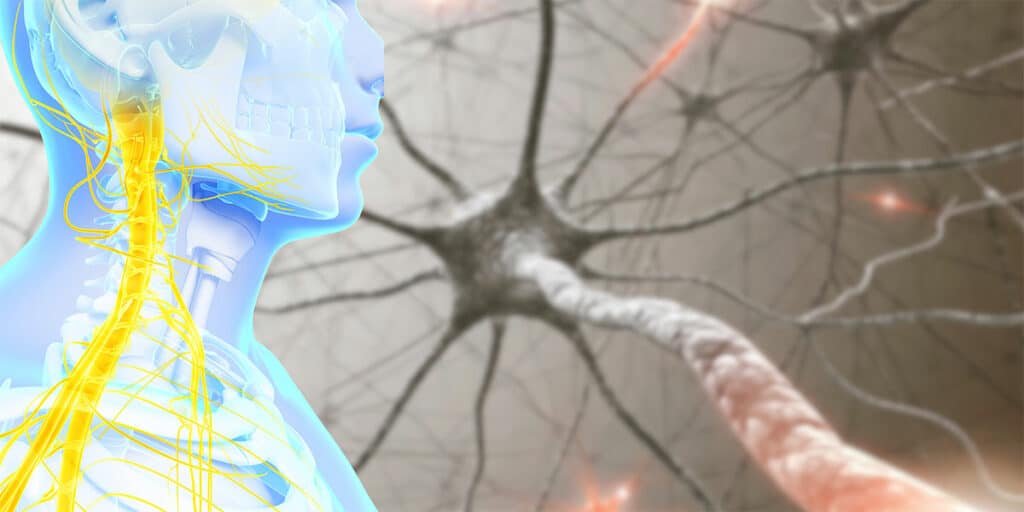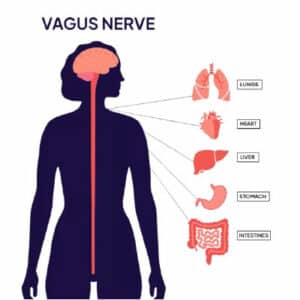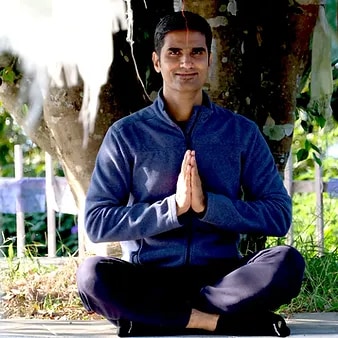Yoga and Vagus Nerve
by Hardik Mehta

In the maze of our body’s intricate network, the vagus nerve emerges as a crucial player, influencing numerous bodily functions, from digestion to mood regulation. Its significance has garnered attention in recent years, particularly in the realm of wellness and holistic health practices like yoga. This blog delves into the fascinating realm of the vagus nerve and clarifies how yoga serves as a potent tool in enhancing vagal tone.
Understanding the Vagus Nerve:

The vagus nerve, also known as the tenth cranial nerve or CN X, is a crucial component of the autonomic nervous system. It originates in the brainstem and extends down through the neck, chest, and abdomen, branching out to various organs throughout the body. It originates in the brainstem and branches out to various organs throughout the body, including the heart, lungs, digestive tract, and even the ears and tongue. The vagus nerve is a major player in regulating numerous bodily functions, including heart rate, digestion, respiratory rhythm, and immune response. It serves as a vital communication highway between the brain and many organs, exerting significant influence over our physiological and emotional well-being. Additionally, the vagus nerve plays a key role in the parasympathetic nervous system, often referred to as the “rest and digest” system, promoting relaxation and facilitating recovery from stress. Its intricate network and multifaceted functions underscore its importance in maintaining overall health and vitality.
Significance of Vagal Tone:
Vagal tone refers to the activity level of the vagus nerve, specifically its ability to regulate parasympathetic nervous system. It reflects the balance between the sympathetic (fight or flight) and parasympathetic (rest and digest) branches of the autonomic nervous system. A higher vagal tone signifies better autonomic function, leading to improved resilience to stress, enhanced digestion, better mood regulation, and overall well-being. Conversely, low vagal tone is associated with various health issues, including anxiety, depression, digestive disorders, and cardiovascular problems. Improving vagal tone through practices like deep breathing, meditation, and yoga can enhance resilience to stress and support overall health and vitality.
Yoga and Vagal Tone Enhancement:
Yoga, an ancient practice originating from India, encompasses a myriad of physical postures, breathwork techniques, and meditation practices. Its holistic approach targets not only the physical body but also the mind and spirit, making it a potent modality for improving vagal tone. Here’s how yoga contributes to enhancing vagal tone:
1. Deep Diaphragmatic Breathing:
Yogic breathing techniques, such as diaphragmatic breathing (or belly breathing), emphasize slow, deep inhalations and exhalations. This type of breathing stimulates the vagus nerve, promoting relaxation and activating the parasympathetic nervous system. Incorporating pranayama (breath control) into your yoga practice can help regulate heart rate, blood pressure, and stress response, thus enhancing vagal tone.
2. Mindfulness Meditation:
Mindfulness practices, integral to many yoga traditions, involve cultivating present-moment awareness and non-judgmental observation of thoughts and sensations. Research suggests that mindfulness meditation can increase vagal tone by modulating stress responses and promoting emotional regulation. By fostering a state of calm and equanimity, meditation cultivates vagal tone and overall well-being.
3. Heart-Opening Asanas:
Certain yoga postures focus on opening the chest and stretching the muscles around the heart region. These heart-opening asanas, such as Bhujangasana (Cobra Pose), Matsyasana (Fish Pose), and Ustrasana (Camel Pose), not only enhance flexibility and posture but also stimulate the vagus nerve. By releasing tension in the chest and promoting circulation, these poses support vagal tone and cardiovascular health.
4. Restorative Yoga:
Restorative yoga emphasizes relaxation and surrender, utilizing supportive props to facilitate deep rest and rejuvenation. This gentle practice encourages the body to enter a parasympathetic state, fostering relaxation and promoting vagal tone. Incorporating restorative yoga poses, such as Supta Baddha Konasana (Reclining Bound Angle Pose) and Savasana (Corpse Pose), into your routine can help alleviate stress and enhance vagal tone.
5. Chanting and Mantra Repetition:
Yoga traditions often incorporate chanting (mantra) as a means of focusing the mind and cultivating inner resonance. The vibration created by chanting resonates in the body, particularly in the throat and chest area, stimulating the vagus nerve. Whether reciting traditional Sanskrit mantras or affirmations in your native language, chanting can have profound effects on vagal tone and emotional well-being.
The vagus nerve stands as a bridge between the mind and body, influencing our physiological responses to stress, emotions, and relaxation. By understanding its significance and leveraging the therapeutic benefits of yoga, we can enhance vagal tone and cultivate greater resilience and vitality in our lives. Incorporating practices such as deep breathing, mindfulness meditation, heart-opening asanas, restorative yoga, and chanting into our routine can serve as powerful tools for nurturing vagal tone and promoting holistic well-being.
Sayujya Yoga stands out as one of the best yoga institutes in Mumbai, India- renowned for its comprehensive 200-hour yoga teacher training course. This program offers a holistic approach to yoga learning, making it suitable even for beginners who are just starting their journey. Sayujya Yoga is particularly esteemed for its Ashtanga Vinyasa courses, which blend modern techniques with traditional practices to provide a well-rounded education in yoga. The 200-hour training course at Sayujya Yoga is meticulously designed to cover all essential aspects of yoga. It delves deep into yoga philosophy, ensuring that students gain a profound understanding of the principles and history of yoga. This knowledge is crucial for those aspiring to become effective and insightful yoga teachers. In addition to theoretical learning, the course emphasizes practical skills that enhance both physical health and overall well-being. Students will learn various asanas, pranayama techniques, and meditation practices, all aimed at fostering personal growth and the ability to teach others with confidence.
About the Author

Hardik Mehta
Hardik is an E-RYT 500 & YACEP (Yoga Alliance Continuing Education Provider), Yoga Alliance, USA. He has been practicing yoga for the last 9 years. Prior to finding his true calling in Yoga, he was working with various corporates for 12 years in the Retail and eCommerce sector.
